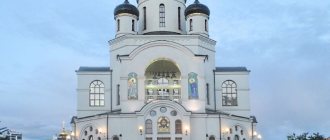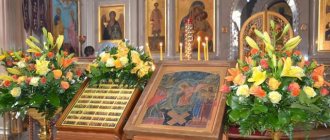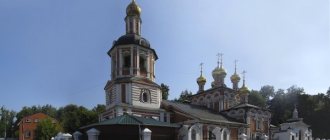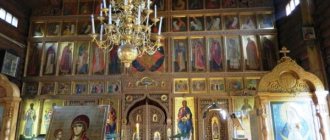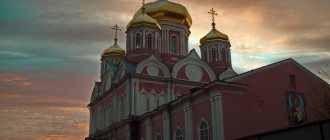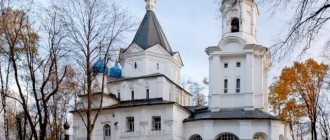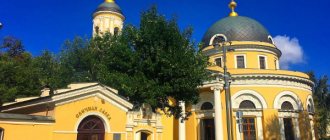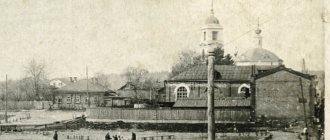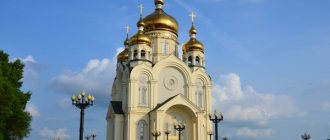Mir
Russia Moscow Church of All Saints in Vsekhsvyatskoe (Moscow) Map is loading...
{"format":"leaflet","minzoom":false,"maxzoom":false,"limit":50,"offset":0,"link":"all","sort":[""], "order":[],"headers":"show","mainlabel":"","intro":"","outro":"","searchlabel":"\u2026 \u0441\u043b\u0435\ u0434\u0443\u044e\u0449\u0438\u0435 \u0440\u0435\u0437\u0443\u043b\u044c\u0442\u0430\u0442\u044b","default":"","import-annotation":false,"width ":"auto","height":"350px","centre":{"text":"","title":"""link":"""lat":55.80389000000000265799826593138277530670166015625,"lon": 37.51389000000000351064954884350299835205078125,"icon":""},"title":"","label":"","icon":"","lines":[],"polygons":[], "circles":[ ],"rectangles":[],"copycoords":false,"static":false,"zoom":8,"defzoom":14,"layers":["OpenStreetMap"],"image layers":[] ,"overlays":[],"resizable":false,"fullscreen":true,"scrollwheelzoom":true,"cluster":false,"clustermaxzoom":9,"clusterzoomonclick":true,"clustermaxradius":80, "clusterspiderfy":true,"geojson":"","clicktarget":"","showtitle":true,"hidenamespace":false,"template":"","userparam":"","activeicon": "","pagelabel":false,"ajaxcoordproperty":"","ajaxquery":"","locations":[{"text":"\u003Cb\u003E\u003Ca href=\"/palomnik/%D0% A5%D1%80%D0%B0%D0%BC_%D0%92%D1%81%D0%B5%D1%85_%D0%A1%D0%B2%D1%8F%D1%82%D1%8B% D1%85_%D0%B2%D0%BE_%D0%92%D1%81%D0%B5%D1%85%D1%81%D0%B2%D1%8F%D1%82%D1%81%D0% BA%D0%BE%D0%BC_(%D0%9C%D0%BE%D1%81%D0%BA%D0%B2%D0%B0)\» title=\»\u0425\u0440\u0430\u043c\ u0412\u0441\u0435\u0445 \u0421\u0432\u044f\u0442\u044b\u0445 \u0432\u043e \u0412\u0441\u0435\u0445\u0441\u0432\u044f\u0442\u 0441\u043a\u043e\u043c (\u041c \u043e\u0441\u043a\u0432\u0430)\»\u003E\u0425\u0440\u0430\u043c \u0412\u0441\u0435\u0445 \u0421\u0432\u044f\u0442\u044b\u04 45\u0432\u043e\u0412\ u0441\u0435\u0445\u0441\u0432\u044f\u0442\u0441\u043a\u043e\u043c (\u041c\u043e\u0441\u043a\u0432\u0430)\u003C/a\u003E\u003C/ b\u003E\u003Chr / \u003E\u003Ca href=\»/palomnik/%D0%A1%D0%B2%D0%BE%D0%B9%D1%81%D1%82%D0%B2%D0%BE:%D0%90%D0 %BD%D0%BD%D0%BE%D1%82%D0%B0%D1%86%D0%B8%D1%8F\" title=\"\u0421\u0432\u043e\u0439\u0441\u0442\u0432 \u043e:\u0410\u043d\u043d\u043e\u0442\u0430\u0446\u0438\u044f\»\u003E\u0410\u043d\u043d\u043e\u0442\u0430\u0446\u0438\u044f \u003C/a\u003E: »'\u0425\u0440\u0430\u0301\u043c \u0412\u0441\u0435\u0301\u0445 \u0421\u0432\u044f\u0442\u044b\u0301\u0445 \u0432\u043e \u0 412\u0441\u0435\u0445\u0441 \u0432\u044f\u0301\u0442\u0441\u043a\u043e\u043c»' \u043f\u043e\u0441\u0442\u0440\u043e\u0435\u043d \u0432 1733\u20141736 \ u0433\u043e\u0434\u0430\u0445\ u0432 \u043f\u043e\u0434\u043c\u043e\u0441\u043a\u043e\u0432\u043d\u043e\u043c \u0441\u0435\u043b\u0435 \u0412\u0441\u0435\u 0445\u0441\u0432\u044f\u0442\ u0441\u043a\u043e\u043c \u043f\u043e \u0438\u043d\u0438\u0446\u0438\u0430\u0442\u0438\u0432\u0435 \u0438\u043c\u0435\u0440\u 0435\u0442\u0438\u043d\u0441\ u043a\u043e\u0439 \u0446\u0430\u0440\u0435\u0432\u043d\u044b \u0414\u0430\u0440\u044c\u0438 \u0410\u0440\u0447\u0438\u043b\u 043e\u0432\u043d\u044b. \u0425\u0440\u0430\u043c \u043e\u0442\u043d\u043e\u0441\u0438\u0442\u0441\u044f \u043a \u0441\u0442\u0438\u043b\u044e \u043 0\u043d\u043d\u0435\u043d\u0441 \u043a\u043e\u0435 \u0431\u0430\u0440\u043e\u043a\u043a\u043e. 1992 1992 1992 1992 1992 \u0430\u0442\u0440\u0438\u0430\ u0440\u0448\u0435\u0433\u043e \u043f\u043e\u0434\u0432\u043e\u0440\u044c\u044f.","title":"\u0425\u0440\u0430\u043c \u0412\u0441\u 0435\u0445\ u0421\u0432\u044f\u0442\u044b\u0445 \u0432\u043e \u0412\u0441\u0435\u0445\u0441\u0432\u044f\u0442\u0441\u043a\u043e\u043c (\u 041c\u043e\u0441\u043a\u0432 \u0430)","link":"""lat":55.80389000000000265799826593138277530670166015625,"lon":37.51389000000000351064954884350299835205078125,"ic on":""}],"imageLayers":[]}
55.803838; 37.513997
Russia, Moscow, Leningradsky prospect, 73A
Moscow
Russia
Telephone
:(499) 157-27-05
Church of All Saints in Vsekhsvyatskoye
built in 1733-1736 in the village of Vsekhsvyatskoe near Moscow on the initiative of the Imeretian princess Daria Archilovna. The temple belongs to the Annen Baroque style. In 1992 it received the status of a patriarchal metochion.
History[edit]
Tsarevna Daria Archilovna was the initiator of the construction of a new church in All Saints, which has survived to this day. In July 1733, a decree was issued to build the church. During the construction work, a linen church in the name of the Epiphany of the Lord was built nearby. By the autumn of 1733, both chapels of the church were built and consecrated: in honor of the icon of the Mother of God “Joy of All Who Sorrow” and in honor of the righteous Simeon the God-Receiver and Anna the Prophetess. In September 1736, the main temple was consecrated.
It is known that the chapel of the temple - Simeon the God-Receiver and Anna the Prophetess - was consecrated in the name of the heavenly patrons of Empress Anna Ioannovna, who stayed in the village of All Saints before her coronation. According to one version, Daria Archilovna did this to avoid disgrace.
Services in the temple until the annexation of Georgia to Russia in 1783 were conducted in the Georgian language. Until the beginning of the 20th century, both Russian and Georgian church ceremonies were held in the church. There was a Georgian cemetery near the temple. The clergy registers for 1788 noted that the wall paintings and plaster inside the temple had faded. In 1798, the Church of All Saints was renovated, an iconostasis was installed in it, and on the left choir there was a royal seat.
In 1812, the temple was destroyed by Napoleonic troops. French soldiers set up a stall for horses in it. But the very next year work began on restoring the church. The main altar was consecrated in 1813, and the side chapels in 1815. The church register of 1822 reports that the church has a dilapidated roof, but “it has sufficient utensils and is splendid with interior decoration.” In 1838, the paintings in the cold church were renewed. In 1846, in the upper altar part of the temple, according to a sketch by the artist F. A. Bruni, the fresco “Cathedral of the Holy Fathers” was created. In 1860, a gilded iconostasis was made in the warm church.
In 1873, there were 1,588 people in the parish of the Church of All Saints (863 men and 765 women), of which 435 people were residents of the village of All Saints. In addition to All Saints, the church parish included Koptevo, Koptevskie settlements, Petrovskoe-Zykovo, Mikhalkovo and Petrovsky Palace. Due to the rapid growth in the number of parishioners in the second half of the 19th century, there was a need to expand the premises of the temple. In June 1884, the temple was inspected by Metropolitan Ioannikiy (Rudnev) of Moscow. After visiting the church, Fr. Metropolitan Ioannikiy decided to begin rebuilding the church in the near future. That same year, restoration work began on the cold church. The icon painter Sokolov restored the iconostasis and painted the walls again.
The project for rebuilding the temple was developed in 1886 by academician of architecture A.P. Popov. In the same year, the refectory was expanded and more favorable air exchange was provided. The refectory pylons were dismantled and the outer walls were moved 2 meters. The church vault was completely rebuilt, so it became almost 4 meters higher.
By the beginning of the 20th century, the population of Vsekhsvyatsky already numbered more than 1,300 people. In 1902, new work began to expand the church. The reconstruction project was developed by the architect N. N. Blagoveshchensky. It was planned to demolish the old walls of the refectory and significantly expand it. Wider windows were made to provide sufficient lighting.
In 1917, the Church of All Saints was located within the city limits of Moscow. In 1923, there were attempts to close the church and turn it over to a nearby factory for a club. However, the church survived, joining the Renovationist movement. Services in the church were performed according to a new rite, and the number of parishioners began to gradually decrease. In 1939, the temple was closed, and its ancient five-tiered iconostasis was publicly burned in the courtyard. A warehouse was located inside the temple. During the war, the 19th century fresco “Cathedral of the Holy Fathers” almost completely crumbled due to dampness.
In 1945, local residents obtained permission to open the temple, and by Easter 1946 it was consecrated again. In many ways, the opening of the temple was facilitated by O. I. Bogoslovskaya, an associate of Elizabeth Feodorovna and the former head of the Romashka sanatorium. She wrote to all authorities, even Stalin, about the need to open a church. I visited Kalinin several times. Bogoslovskaya contacted Georgian writers and poets, pointing out that the temple was a monument to Russian-Georgian friendship. After the opening of the church, the parishioners elected her as an elder. According to old-timers and church ministers, Stalin visited the temple several times.
In 1946, a new iconostasis was installed in the temple. Painting was resumed in the 1960s. In 1979, after a long break, the temple bell rang again. In the 1970s, the temple was repainted red, according to church canons. But in the 1980s, at the request of parishioners, the temple was returned to its previous yellow color.
In Soviet times, the temple had a lot of parishioners. In the 1970s, his parish was the largest in Moscow. According to eyewitnesses, on some days, when holy water was being distributed in the temple, the line for it stretched for more than a kilometer. The main reason for its popularity was the fact that there were almost no other operating Orthodox churches in the north and north-west of Moscow. Due to the large number of parishioners, in 1981 a fourth altar was consecrated in the church.
In 1992, the temple received the status of a patriarchal metochion. In the second half of the 2000s, restoration took place in the temple. The paintings were updated, and external façade work was carried out. Chimes were installed on the bell tower. The outside of the church was decorated with mosaics. In addition, a new two-story parish house was built on the church grounds, which housed a Sunday school and a church store. In one of the premises of the old parish house, a baptismal church was built, consecrated in honor of the Epiphany.
Photo of the Church of All Saints on Sokol
The Church of All Saints in the rays of the spring sun; if you look closely, you can see a slight angle of inclination of the bell tower.
Inside the temple you can clearly see the iconostasis, which is a recreation of what was lost in the 40s.
Church of All Saints from the main entrance.
Current state[edit]
Architecture[edit]
The architecture of the church dates back to the early Baroque and is an intermediate link between the churches of Peter the Great and the developed Baroque buildings of the mid-18th century. Churches of this era are characterized by heavy proportions.
The church has a three-part longitudinal-axial “ship” structure. The architecture of the building belongs to the common type of “Eight on a Quad”. Adjacent to the quadrangle (the main volume) is a two-limit refectory, a semicircular apse and a bell tower of the same width. The octagon covered with a closed vault does not play a significant role in the volumetric composition of the church. It rests on the walls of the quadrangle and on the stepped tromps. From the outside, the figure of eight is perceived as a pedestal for the dome. In the vault of the temple there are large false lucarne windows, which appeared in the late 1960s (in the 2000s the lucarnes were sealed and painted on the outside). The walls of the refectory have large semicircular windows, between which there are side pilasters and horizontal cornices.
The bell tower of the All Saints Church has three tiers and was built entirely in the style of Moscow architecture of the early 18th century. An octagonal pillar rests on the two-tier base of the bell tower. It has narrow arched bell openings. A characteristic feature of the bell tower are the semi-domes in the tympanums, which visually soften the transition from the quadrangle to the octagon. The staircase to the bell tower begins in the thickness of the western wall of the refectory and has its own entrance from the outside.
The temple underwent significant reconstruction. Initially, the refectory had four round columns on which the vault rested. In 1886, according to the design of the architect A.P. Popov, the refectory was rebuilt: the columns were removed, a single vault was erected, and the walls were raised. In 1902-1903, according to the design of the architect N. N. Blagoveshchensky, the refectory was rebuilt again: the side aisles were expanded.
The bell tower of the temple is often called one of the “Leaning Towers of Pisa” in Moscow - it has an inclination of about 5 degrees. There is an opinion that the tilt of the bell tower occurred due to the influence of the waters of the Tarakanovka River, enclosed in a collector, the proximity of the metro and the characteristics of the soil (it is no coincidence that the local streets are called Sandy).
Interior[edit]
The temple has wall paintings inside. The largest pictorial composition in the church, “The Cathedral of All Saints,” is located above the main iconostasis. It was made in the late 1940s in the Vasnetsov style. The composition depicts Orthodox saints in prayer. Among them are saints revered in Georgia: Nina, Tamara and Daria. On the walls of the octagon, on the vault of the temple and in the apse, oil paintings, executed in 1884 in the manner of late academicism, have been preserved. Some of the temple's paintings were done in the 1960s.
The central carved iconostasis was made in the late 1940s in the pseudo-Russian style. It has three tiers. The iconostases of the side chapels were also made at the same time. The color of the iconostasis is white-cream with gilding. In the western part of the refectory, above the entrance, there are choirs. Several memorial plaques dedicated to the priests and representatives of the Georgian princely families buried here have been preserved on the walls of the temple.
Cemetery at the temple[edit]
The cemetery at the Church of All Saints has been known since the 18th century. Many representatives of the Georgian princely families (Bagrations, Tsitsianovs and others) were buried here. According to some reports, the Georgian writer Sulkhan-Saba Orbeliani is buried at the All Saints Cemetery. At the end of the 19th century, wealthy peasants were buried in this cemetery. At the same time, ancient gravestones were often destroyed or moved from place to place.
The cemetery existed until 1982, after which it was destroyed by order of the liquidation of cemeteries within Moscow. According to one version, high-ranking residents of the neighboring “General’s House” contributed to the demolition of the tombstones. Many of them were not happy with the view of the cemetery from the window.
Nevertheless, some tombstones have survived to this day. Among them is the tombstone of Prince Ivan Alexandrovich Bagration (1730-1795). The monument was erected at the grave by his son, the great commander Pyotr Ivanovich Bagration. The monument is a fluted pyramid on a high pedestal. The tombstone of I. A. Bagration repeatedly changed its location. Now it is installed to the north of the temple near the “Reconciliation of Nations” memorial. The tombstone of I. A. Bagration is a historical monument of federal significance.
Memorial "Reconciliation of Peoples"[edit]
The memorial “Reconciliation of the peoples of Russia, Germany and other countries who fought in two world and civil wars” was installed in 1994-1998 on the territory of the Church of All Saints on the initiative of a group of veterans of the Great Patriotic War and other private individuals[30]. It includes several memorial plaques and crosses dedicated to the victims of the Crimean, Balkan, Russo-Japanese, World War I, Civil and First Chechen wars, as well as victims of the Red Terror, representatives of the White movement and Cossacks. Some of the monuments were initially installed on the territory of the former Moscow City Fraternal Cemetery, and then moved to the Church of All Saints.
The installation of a slab dedicated to the commanders of the 15th SS Cossack Cavalry Corps, which fought in World War II on the side of Nazi Germany, caused a wide public outcry. Attempts were made repeatedly to achieve the demolition of this monument, but they were unsuccessful. On May 8, 2007, on the eve of Victory Day, the slab was broken by unknown persons (according to the Moskovsky Komsomolets newspaper, the slab could have been broken by members of one of the radical left organizations). The rector of the temple, Archpriest Vasily Baburin, noted that this slab has nothing to do with the Church of All Saints. A small fragment remained from the monument until in 2014 it was replaced with a slab “To the Cossacks who fell for the Faith, the Tsar and the Fatherland.”
Activities of the parish[edit]
The church has a Sunday school for children and a children's choir. Sunday school for adults, singing school, Church Slavonic language courses. Youth organization, pilgrimage service, social service group, prisoner assistance group.
Architectural and cultural landmarks
- The temple was built in the style of the so-called “Anne” Baroque. The bell tower is three-tiered, the base is tetrahedral, on which an octagonal extension is installed. It is noteworthy that the structure has a slight slope, which is due to the local soil factor.
- The temple has rich paintings. Unfortunately, almost no original works have survived to this day, but in some places fragments of the 19th century have been preserved.
- Near the temple there was a cemetery where many representatives of noble Georgian families were buried. It was liquidated in the 1980s, but some monuments have survived.
- In the 1990s, a memorial complex “Reconciliation of Nations” was opened at the temple, in memory of those who died in the wars of the 19th-21st centuries.
Shrines[edit]
Reliquary
- Holy myrrh from the myrrh-streaming heads of the Kiev-Pechersk saints
- Stone of Mount Sinai
- St. stone Seraphim of Sarov
- Stone of the coffin of St. Leonida
- Nail from the coffin of St. Ambrose of Optina
- Palma St. Savva the Sanctified
- Part of the Life-Giving Cross of the Lord
- Part of St.'s clothing Philaret of Moscow
- Part of the mantle of St. Seraphim of Sarov
- Part of the mantle of St. John, new Jerusalem
- Kazan Icon of the Mother of God
- Icon of St. Nicholas the Wonderworker
- Icon of All Saints
- Icon of the Mother of God “Joy of All Who Sorrow”
- Pieces of the relics of many saints
It took about 50 years for the temple to be restored after being plundered by Napoleon's army.
But the temple was left in a terrible state for a short time. A year later they began to restore it.
According to Christian tradition, a temple that has been looted and even refurbished is considered desecrated. In such cases, it needs to be re-consecrated. Therefore, in 1813, the main altar was consecrated, and the side chapels began in 1815.
Restoration work continues in subsequent years. They are walking very slowly. Historical documents report the production of the iconostasis in 1860.
Today the temple has many functions - from educational to psychological
Today the temple is actively involved in public activities. Among its functions are the following:
Management of four subordinate temples:
- Church of the Intercession of the Blessed Virgin Mary in the Pokrovskoe-Streshnevo estate;
- Chapel of the Transfiguration at the Fraternal Military Cemetery;
- Chapel of the Arbatets cemetery.
Education: there is a Sunday school at the temple, where adults and children are taught the following disciplines:
- Old Testament;
- New Testament;
- Church Charter;
- God's Law;
- Church Slavonic language;
- History of Christianity;
- Church singing;
- Temple.
Psychological and social assistance:
- an Orthodox psychologist is ready to provide free consultations to everyone;
- family sobriety club helps fight addiction;
- A full-time social worker helps people in difficult life situations.

